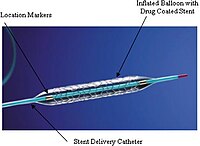
Photo from wikipedia
Objective Mesenteric angioplasty and stenting (MAS) has surpassed open revascularization as the treatment of choice for mesenteric ischemia. Despite the lower perioperative mortality associated with MAS, the need for reintervention… Click to show full abstract
Objective Mesenteric angioplasty and stenting (MAS) has surpassed open revascularization as the treatment of choice for mesenteric ischemia. Despite the lower perioperative mortality associated with MAS, the need for reintervention is not infrequent. The purpose of this study was to review the outcomes of patients treated for mesenteric artery in‐stent restenosis (MAISR). Methods Clinical data from a single center between 2004 and 2017 were retrospectively analyzed. Standard statistical analysis including Kaplan‐Meier estimate for time‐dependent outcomes, χ2 test for categorical variables, and two‐sample t‐test for continuous variables was performed. Primary end points included stent patency and reintervention rate. Secondary end points included mortality and morbidity. Results During the study period, 91 patients underwent primary MAS. In total, 113 mesenteric vessels were treated with 20 covered stents and 93 bare‐metal stents. Overall primary patency was 69% at 2 years. At 2 years, primary patency was 83% for covered stents compared with 65% for bare‐metal stents (P = .17). Of these 91 primary MAS patients, 27 (30%) were treated for MAISR (32 vessels). Two covered stent patients developed significant restenosis (11%) compared with 25 (34%) bare‐metal stent patients (P = .02). The mean age of patients requiring reintervention was 69 years (36% male), with the majority having a history of tobacco use (85%), hypertension (75%), and hyperlipidemia (78%). Fourteen reintervention patients (52%) presented with recurrent symptoms, 10 (37%) had asymptomatic restenosis, and 3 (11%) developed intestinal ischemia. Twelve patients (44%) underwent reintervention with balloon angioplasty alone and 15 (56%) underwent repeated stent placement. Of the 15 patients who had repeated stent placement, 7 patients had covered stents placed. The 30‐day mortality rate after reintervention for mesenteric stent restenosis was 0%. Postoperative complications occurred in 15% of patients (myocardial infarction, 4%; reversible kidney injury, 4%; and bowel ischemia requiring surgical exploration, 7%). There was no difference in the perioperative morbidity in comparing symptomatic and asymptomatic patients undergoing reintervention. Mean follow‐up after mesenteric reintervention was 31 months, with one‐third of patients (n = 9) requiring another reintervention because of either recurrence of symptoms or asymptomatic high‐grade restenosis. Assisted primary patency at 2 years was 92% after reintervention with balloon angioplasty and 87% for repeated stent placement, with no statistically significant difference between the groups (P = .66). Conclusions Treatment of MAISR is associated with low mortality and acceptable morbidity. The initial use of covered stents may reduce the need for reintervention.
Journal Title: Journal of Vascular Surgery
Year Published: 2019
Link to full text (if available)
Share on Social Media: Sign Up to like & get
recommendations!